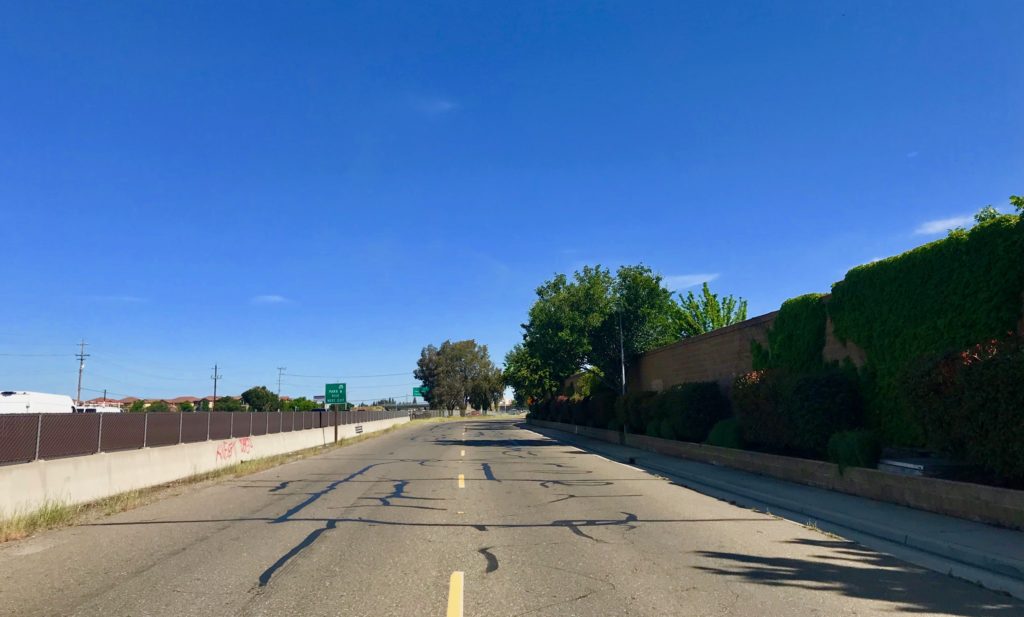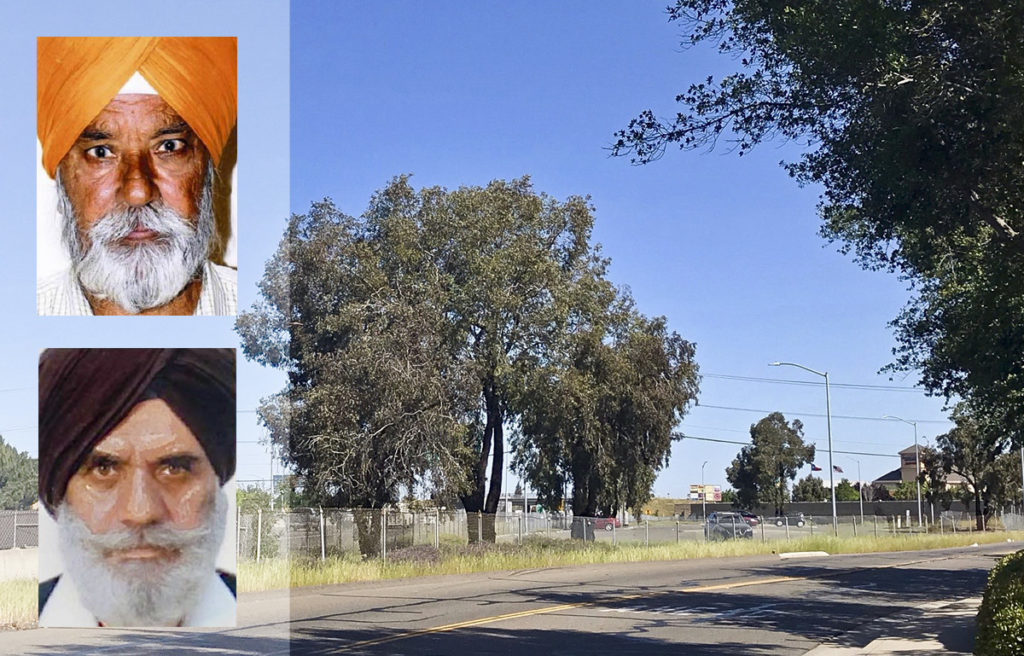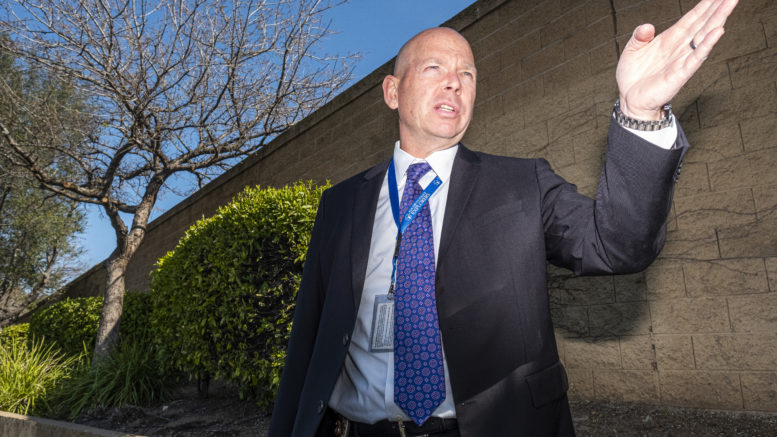In Elk Grove, on an anonymous strip of East Stockton Boulevard, there’s a short-running section of divider that shields the avenue from the gagging exhaust of Highway 99. This concrete barrier has thin, plastic, wire-bound planks running across the top. They’re a shabby, bleached-brick maroon color. They don’t even rise six feet off the ground.
Yet, as cars and trucks approach, the slotted spacing of those planks create a cloaking effect on both sides of the divider: Freeway drivers are coming in a straight line for a mile, but anyone standing here won’t see them until the last few seconds, when they briefly morph from russet blotches to clear-moving blurs — then disappear again into the fence’s mirage.
For that same span of time, the freeway drivers can’t see what is happening on East Stockton Boulevard, either.
As Elk Grove Police Detective Mark Bearor glances at the divider, it’s nine years to the day when those flimsy planks may have knee-capped his department from solving the most jarring double homicide in the city’s history.
It was March 4, 2011, a clear Friday with high clouds and calm winds. The afternoon rush hour was building to full-steam on the freeway. A woman on the highway’s opposite frontage road heard gunshots. She glimpsed what looked like a tan Ford F150 pickup driving away from the sound. Other people noticed it, too. The truck wasn’t driving fast — just steadily cruising down East Stockton Boulevard toward the neighborhoods to the south.
Seconds later, motorists approaching the corner of East Stockton and Geneva Point Drive spotted two older men wearing turbans. One was on the ground in a disturbing way. The other was struggling by the brick sound wall. Good Samaritans started pulling over. The first ones who rushed over saw blood. There was blood on the men’s clothes. There was blood spread on the ground. Not far away, shell casings were on the pavement, cooling.
The Elk Grove police officers who soon arrived weren’t just walking into a tangle of ambulance lights, paramedics and stunned witnesses, the were stepping into a murder probe that would come to haunt their department, and the city, for the better part of a decade.
Now, Bearor is standing where it happened as he contemplates the anniversary of the crime. With him is officer Jason Jimenez, who was a patrolman on the day of the murders. Jimenez remembers a kind of shock spreading through the city. Surinder Singh and Gurmej Atwal were grandfathers and respected family men in Elk Grove’s Sikh community. They were friends. They took walks together. They were known to wave at people in the neighborhood.
On that Friday in 2011, the men were enjoying a stroll when they paused to chat on a planter box. That’s when they were gunned-down from out of nowhere. The person pulling the trigger never left the truck.
“There was that question from the start, ‘Why these two gentlemen?’”
Elk Grove Police Chief Timothy Albright
It was an act that caused Sihks in Elk Grove’s to wonder if a killer was stalking them. Detectives like Bearor had to consider that, but they also had to digest the unbelievably brazen way the assassinations were carried out. The shooter had fired in broad daylight on a busy frontage road. His targets were seated 170 yards from a bus stop and park-and-ride lot just when there were people getting off work. And then there’s the freeway, and the bewildering fact that hundreds of cars were passing by — just 28 feet to the right — in the span of time it took the killer’s truck to stop, release the gunfire and then casually drive off.
There should have been numerous eyewitnesses on Highway 99. There would have been — if it hadn’t been for the spacing of those bland plastic fence posts.
In the intervening years, the Elk Grove Police Department has gone through numerous doorways of inquiry and tugged on dozens of investigative threads. Nevertheless, the case went cold. But on its nine-year mark, the department is still not giving up. Last November, its new police chief, Timothy Albright, decided to steer additional resources into seeking out the ambusher who’s responsible. Specifically, he tapped Bearor to wade through every part of the enigma again, searching for any piece, looking for any person, that might have been missed before.
From that moment to this moment, that’s exactly what the detective has done. Today, he speaks about the case with an air of cautious optimism.
“A lot of things have become more clear,” he says.
The first hours

Albright was a watch commander when Singh and Atwal were shot. The images of that night remain fresh in his memory, especially watching his department race against time. The crime scene was being contained, photographed and videotaped. Neighborhoods down the way and across the freeway were being canvassed. Officers were entering nearby businesses to search for video surveillance footage. Detectives were vetting as many incoming tips as they could.
Officers also put a roadblock on East Stockton Boulevard to speak with dozens of commuters.
“There was that question from the start, ‘Why these two gentlemen?’” Albright recalls. “I thought, ‘This doesn’t make any sense.’”
Two days later, Bearor came on shift and began assisting the lead detective, Kevin Papineau.
At Kaiser South Sacramento Medical Center, Atwal was still clinging to life. For a time, his condition was critical but stable. There was a chance he might actually pull through. But then things turned darker. Atwal was deteriorating. Soon, a second Elk Grove family was in mourning — and detectives had lost a vital chance at unlocking the mystery.
Then and now, Elk Grove averages one to three homicides a year. The cold-blooded attack on two senior citizens with no apparent enemies landed like a bomb in the city.
“A double-shooting like that was a shock to the conscious of the community,” Albright admits.
At a candlelight vigil to honor Atwal and Singh, hundreds from all faiths and walks of life came to support the families. The police were part of it, too. They were starting to get contacts at the local Sikh temple and make inroads within the victims’ circles. They needed help — and they needed answers. This wasn’t a case that came wrapped in a bow: Since the shooter never existed the truck, there was no DNA evidence at the scene. The best eyewitnesses had been a considerable distance from the victims, with obstructions hindering their views. Back then, powerful cell phone cameras weren’t a ubiquitous part of daily life.
“We didn’t have what we have now, in term of traffic cameras,” Bearor notes. “Some of the video evidence we have is not high-definition. It’s early digital video, so it lacks resolution.”
The detectives also had to start looking at why Singh and Atwal were targeted. Two of the most obvious possibilities were both disturbing. Both victims had traditional Sikh beards and wore Sikh attire. Investigators had to consider that this might have been a murderous hate crime. Or, it could have been a heinous act of sheer opportunity — a thrill killing. Investigation 101 is to keep an open mind while following the evidence, so other motives were possible.
But there is one thing the detectives remain pretty sure about.
“The person is still a dangerous individual in our community,” Bearor says. “And that includes to the people around them. If they are capable of killing someone in this manner, they’re capable of harming anybody, not to mention those who are close.”
A case for cracking ice

On the ninth anniversary of their deaths, Atwal and Singh have the sad distinction of being the faces behind the longest-running unsolved murder case in Elk Grove’s history.
In the initial years of the probe, Bearor was a back-up detective. Papineau was the main investigator working the angles. He kept the case in the public eye. He tried to spur more tips coming in, while carefully holding back details that only the killer, detectives or real witnesses would know, like the caliber of the bullet that was used. For all work Elk Grove PD was doing, the case was beginning to stall. But Papineau’s efforts did make progress in the sense they eliminated many potential suspects who were known to the victims.
In a 2016 television interview, Papineau tried to quell some of the uglier rumors that were going around.
“Some people make assumptions about the Sikh community, that they assume there was something crooked going on, and that they were killed by someone within the community,” Papineau had said. “We’ve investigated these men’s lives, their families, their temple affiliations. We’ve gone everywhere we can to find some reason that somebody would want to kill these guys, and we haven’t come up with that.”
In the absence of suspects connected to the victims, the lingering question about what happened on that March afternoon turns back to those two unsettling possibilities. Was this a hate crime? Was this a thrill killing?
And, for the Sikh community, a broader question: Will there ever be justice?
When Albright was sworn-in as Elk Grove new police chief on September 3, a few local Sikhs approached to ask if he’d consider looking at the case again.
“The bottom line is, these are two gentlemen who were taken from their families, and we don’t know why,” Albright says. “And that weighs heavy on this community, and on this organization.”
Albright held a press event that November. He emphasized that his detectives were digging in yet again, stressing there was a $57,000 reward for information leading to an arrest and releasing images of the crime scene and sketches of the suspected vehicle.
Papineau was tackling new assignments, so Albright turned to Bearor.
“I’ll tell you, if my family were ever the victim of a crime, that’s the person I’d want investigating it,” the chief notes. “He’s seasoned and he just sees things a little differently, which I think we need at this point. That’s one of the dynamics of a cold case, the ability to re-read it, or read it for the first time with an insight somebody else didn’t see.”
“The person is still a dangerous individual in our community. And that includes to the people around them.”
Elk Grove Police Detective Mark Bearor
Bearor has been working 10-hour days since then, focusing all his energy on how events converged that roaring moment of gunfire. He’s plowed through volumes of crime scene photos, sketches, videos, audio interviews and supplemental reports. He’s been meticulously fine-tuning the timeline as a way of further reconstructing the crime scene. For Bearor and Albright, the “why” would be good to know, but it is the “who” that’s everything at this point.
“The longer the case goes on, the more issues we have, but the nice thing is I’ve had opportunity to take a break from my regular caseload and really take the time with the evidence,” Bearor says. “It’s going back over things, trying to make sense of it all. It’s a matter of saying, ‘Ok, we might have believed this back then, but is there evidence to suggest it’s true and accurate?’ If not, let’s figure out what is, and then make sense of that.’”
What are Elk Grove PD’s odds for solving the case? Detectives won’t divulge details about new opportunities to identify who owns that tan or light brown Ford F-150 pickup, believed to be a 1997 to 2003 model with a standard single cab. However, Bearor and Albright will talk about one abiding conviction they share.
“Somebody knows this person,” Bearor says of the killer. “And they probably talked to someone about their involvement in this crime … We do believe there is someone out there who has information.”
The chief hopes “the teacher of time” will prod a witness to finally make the right decision.
“The years passing may have allowed for people to just compartmentalize and not think about it,” Albright reflects. “I’ll do anything I can to try to convince someone to come forward. I’ll beg if I have to, but we want to know. Two families were destroyed by this.”
Scott Thomas Anderson is also the writer-producer of the true crime podcast series ‘Trace of the Devastation’



Be the first to comment on "After nine years, Elk Grove detectives won’t let an infamous case stay cold"